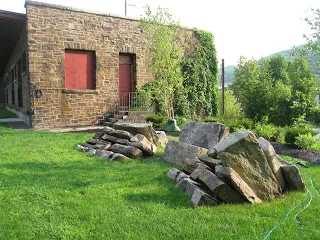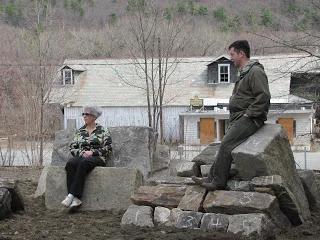Upon completion, the Bauble perched on its temporary base in the sugarhouse woodshed for three months while the adhesive that held it together cured.
Read MoreEven without the silhouette of a crosswalking pedestrian or leaping deer, road signs with a triangular outline convey a message of caution; warning the traveler to be aware of what lies ahead. The sharp angles draw attention because they represent sudden change. Survival of the human species has depended on the ability of individuals to recognize signs of change and to adapt quickly to new situations.
Read MoreExcavation of the hillside spring revealed layers of geologic stratification. Top soil lay on coarse gravel over pure sand on top of clay hardpan. The design called for ground water that trickled out of the sand layer to be trapped in a hollow under a half-shell overhang. Recycled slate from building foundation ruins and cobbles from a gravel pit were combined to shape the dry stone installation.
Read MoreThere’s a certain satisfaction in doing something yourself that can’t be achieved in any other way. It’s not that other satisfactions have less strength or value, they’re just different. Each and every stone laid in the creation of the Pumpkin Seed garden enclosure passed through my hands. I say that with pride but also in the full knowledge that a team of wallers under my direction and following my design could have built the structure to a high standard without my lifting a finger. So, for me, it’s not the final result that distinguishes the piece, it’s the process I went through in the past few months to get it there. The daily figuring-out of what needs to happen next and how to get it done under the prevailing field conditions is what the Seed is made of in my mind’s eye.
Read MoreThere are steps along the way to completing a project that deserve celebration. Yesterday the north wall of the “pumpkin seed” garden fence was topped out at its eight foot height. While clambering around on ladders and icy boulders is exhilarating in its own way, I’m glad to be finished with this stage of the work. Left to do on the fence is the final course of coping stones and filling in the break in the wall line that’s been used for loader access to the garden’s interior.
Read MoreThe seed shape is fructuous. Its asymmetricality suggests continued growth and development. The entry point of the garden, the pinched end of the seed, expresses the concept of compression used by architect Frank Lloyd Wright in his design of foyers. His idea was to constrain the vestibule area to hasten movement toward the voluminous inner space. Compression springs expansion. The sense of garden bountiful is increased by passing through a narrow portal.
Read MoreIn the beginning the idea was to make it a solitary object out in the field north of the garden. I had visions of a compost carousel with four pie-shaped stalls. Then it was a long barrow-shaped affair with tractor ramps to the top of the bins. I knew little about composting but I was having lots of fun with modeling clay imagining the construction of a dry stone Ruminator. Scale model making is an enjoyable pursuit that helps develop spatial acuity. The process of shaping clay is slow enough for deliberation to take place and fast enough for a form to observably emerge. Results unfold in an organic fashion.
Read MoreThe age-old skill of constructing in dry stone is still alive today and being practiced by a growing number of professional wallers. Two weeks from now, a team of DSWA certified craftsmen from around the region will meet at the Champlain Valley Fairgrounds in Essex Junction, to create a unique feature (scale model in photo) for the upcoming Vermont Flower Show.
Read MoreMy project this month is the construction of a series of retaining walls for an existing perennial garden. A brook trickles from the bank at the top of the garden and flows through a channel between two of the new walls. The grotto will become an ice cavern in winter months and a cool, shady retreat in the heat of summer.
Read MoreIn late autumn of 2011 Gordon Hayward called to say that Teddy Berg had asked him to write a book about her gardens on Rice Mountain in Walpole, New Hampshire. He wanted to know if I’d care to contribute a few essays, and, of course, I said I’d be pleased and honored to do so. ‘Gardening on Granite’ is hot off the presses this month. It’s a large-format book packed with gorgeous photographs and a lovingly told, personal history of a very special place and time.
Read MoreDuring my working life I’ve shifted freely, back and forth, from artist to dry stone waller. Whatever the final outcome of any work, it’s been the making that I’ve liked the best. With ‘Rock Rest’, I enjoyed the creative process so much that I built the piece twice; once in my Dummerston stone yard and once here beside the museum. The stone was initially collected from a steep slope on a wooded property in Townshend. It lay there for twelve thousand years after being plucked from the ledges by the last ice age. In ‘Rock Rest’ I’ve attempted to simulate the natural process that turns bedrock into loose stone. I’ve always been fascinated by the way stones separate from one another but lock more tightly together as they slide apart.
Read MoreThe techniques used to set stones in relation to one another can be varied. The sizes and shapes of the stones in any supply are often the final determining factor in the design of a dry stone structure. The supply limits the possibilities, focusing the process of design on what is doable. Limits actually increase the potential for a successful outcome. By first assessing the qualities of the available stone, a more ornamental or contemporary design might be considered and pursued.
Read MoreThree days this week were devoted to dismantling and reassembling a sculpture titled ‘Rock Rest’. The piece was designed and constructed last December at my stone yard with the intention that it would eventually be installed at the Brattleboro Museum and Art Center’s new sculpture garden. On Sunday I numbered and catalogued the 50+ stones in the piece and transported them, by five truck and trailer loads, seven miles to Brattleboro. The stones were spread out across the parking lot in preparation for placement in the piece.
Read More











